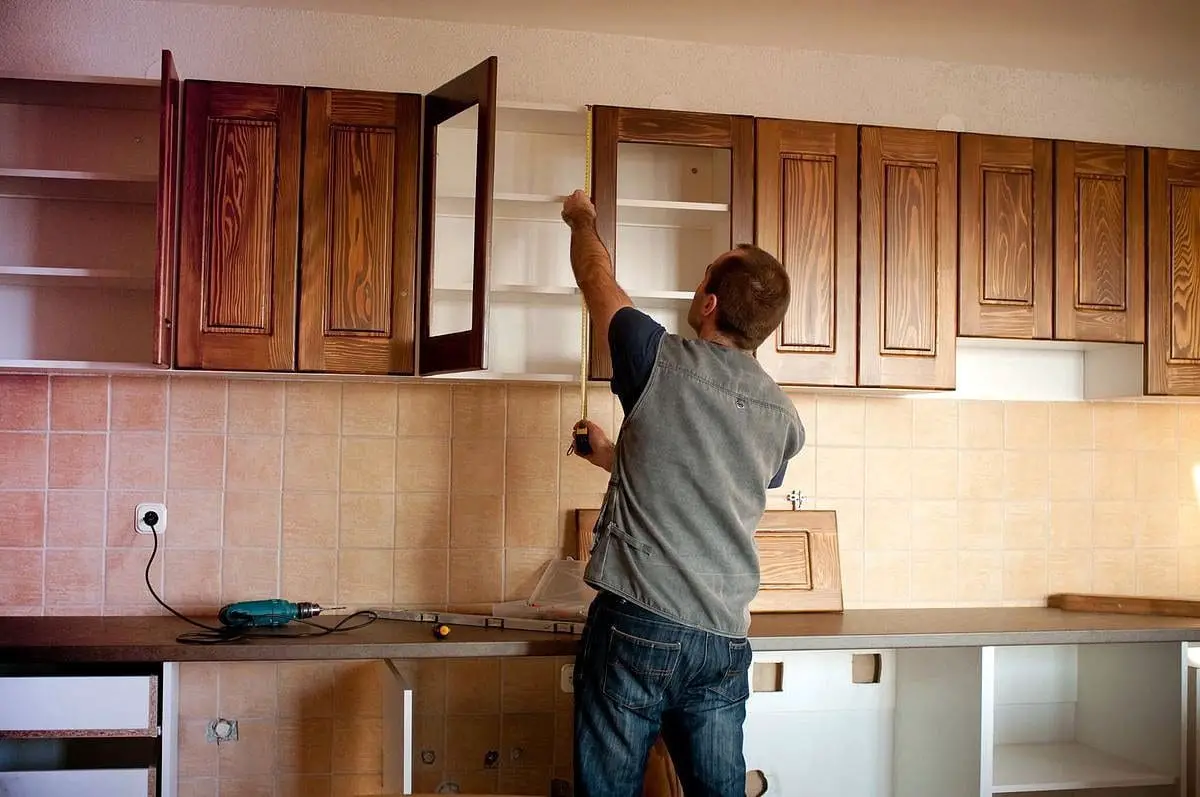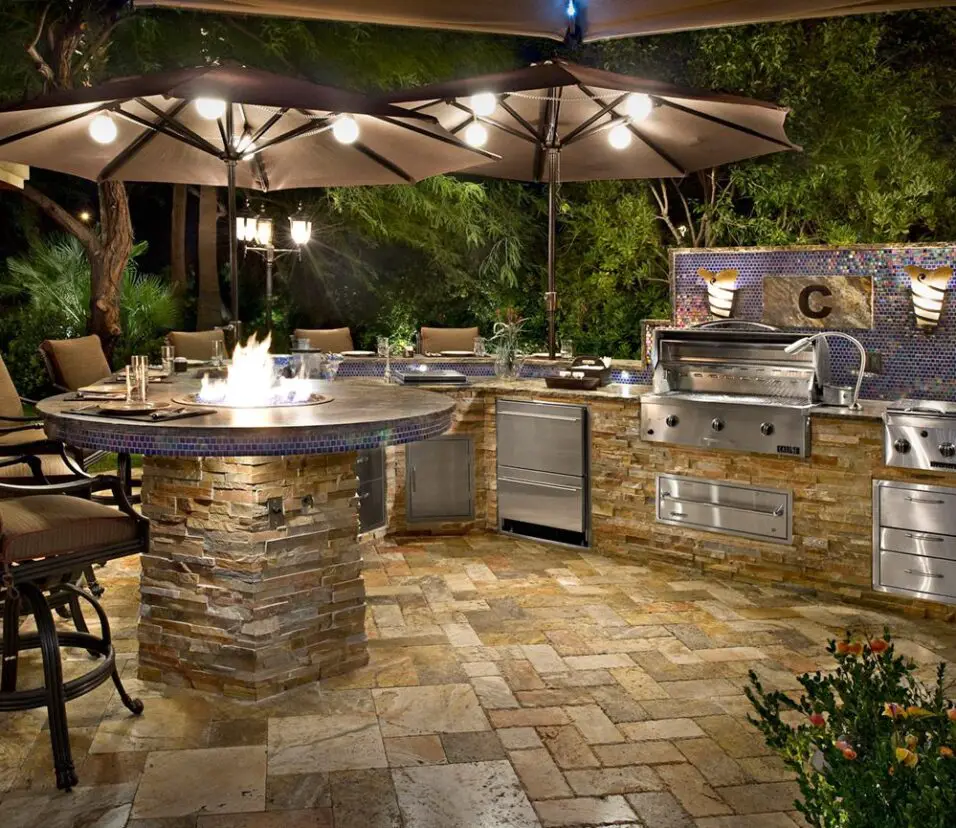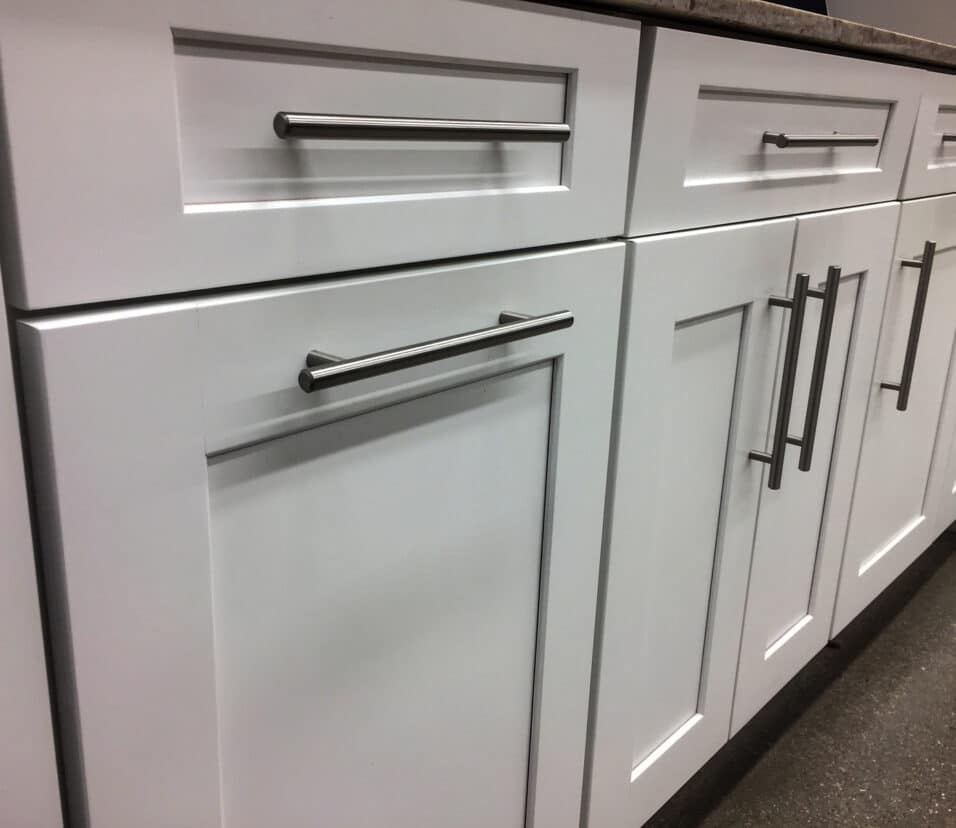How To Clean Moldy Kitchen Cabinets
Introduction
How To Clean Moldy Kitchen Cabinets: Mold is not only unsightly but can also pose health risks if left unchecked. Whether you’ve just discovered a few spots of mold or are dealing with a full-blown infestation, this step-by-step guide will equip you with the knowledge and techniques to safely and effectively restore your kitchen cabinets to their pristine condition.
Before we begin, it’s essential to understand that mold thrives in damp and dark environments, making kitchen cabinets a prime target, especially in humid climates or where there has been water leakage. As with any cleaning task, safety should be your top priority. Wear appropriate protective gear, such as gloves, a mask, and eye protection, to avoid direct contact with mold spores and potential respiratory issues.
We’ll cover how to assess the severity of the mold, what cleaning supplies you’ll need, and step-by-step instructions to remove the mold and prevent its return. We’ll also provide tips on maintaining a mold-free kitchen environment to keep your kitchen cabinets looking fresh and safeguard your family’s health.
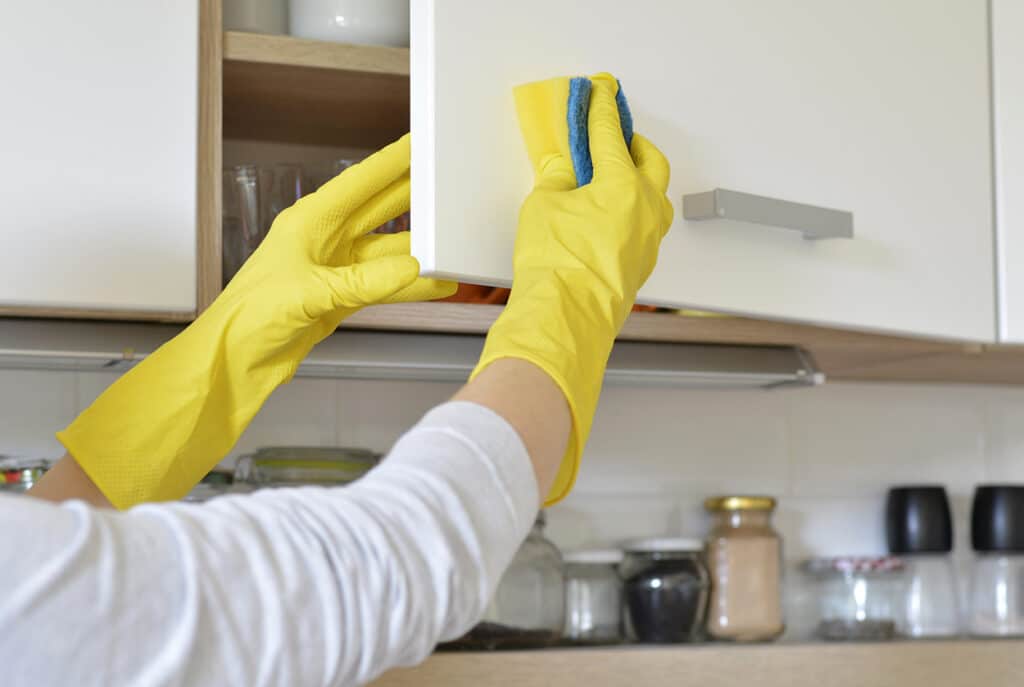
What kills mold on kitchen cabinets?
Mold in Cabinets and Cupboards
Because these spaces are mostly poorly lit and inadequately ventilated, molds will grow there because of the dampness and moisture. To get rid of the mold from kitchen cabinets, you can use distilled water, vinegar, or detergent mixed with water in a spray bottle.
Before you begin the cleaning process, it’s crucial to assess the extent of the mold infestation on your kitchen cabinets. Small, isolated patches can often be managed with DIY cleaning solutions, while more extensive and stubborn mold growth may require professional assistance. Take the time to examine the cabinets thoroughly to determine the appropriate course of action.
Safety should be your top priority when dealing with mold. Before you start cleaning, ensure you have the right protective gear, such as gloves, a mask, and eye protection, to avoid direct contact with mold spores and potential respiratory issues. Keep the area well-ventilated during the cleaning process to reduce exposure to airborne mold particles.
There are several natural and eco-friendly solutions that can effectively kill mold on kitchen cabinets. White vinegar is a potent mold-fighting agent, thanks to its acidic nature. Mix equal parts of white vinegar and water in a spray bottle and apply it directly to the moldy areas. Let it sit for a few minutes before scrubbing the mold away with a soft brush or cloth.
Baking soda is another excellent natural option. Create a paste by mixing baking soda with water and apply it to the mold-infested areas. After letting it sit for a while, scrub gently and rinse thoroughly.
Essential oils like tea tree oil, grapefruit seed extract, or eucalyptus oil have natural anti-fungal properties and can be mixed with water to create a potent mold-killing solution.
If the mold infestation is more severe or persists despite natural solutions, consider using commercial mold cleaners. Look for products that specifically target mold and follow the manufacturer’s instructions carefully. Keep in mind that some commercial cleaners may contain harsh chemicals, so make sure to wear appropriate protection and keep the area well-ventilated.
How do you permanently remove mold from cabinets?
Mold in Cabinets
Make a solution of half water and half detergent by combining it into a spray bottle, or use a commercial mold cleaner. Use the solution and a scrubbing brush (or toothbrush for corners and hard-to-reach areas) to remove the mold. Wipe the residue with a wet clean rag and rinse with a dry rag.
The first step in permanently removing mold from cabinets is to identify and address the source of moisture that is promoting mold growth. Mold thrives in damp and humid environments, so inspect your kitchen thoroughly for any leaks, plumbing issues, or high humidity levels. Fixing these problems will create a less conducive environment for mold to grow and prevent its return.
Before you start the cleaning process, ensure you take proper safety precautions. Wear protective gear, including gloves, a mask, and eye protection, to minimize direct contact with mold spores and potential respiratory issues. Keep the area well-ventilated during the cleaning process to reduce exposure to airborne mold particles.
Natural cleaning solutions are effective and safe for removing mold from cabinets. White vinegar, due to its acidic nature, is an excellent mold-fighting agent. Mix equal parts of white vinegar and water in a spray bottle and apply it directly to the moldy areas. Let it sit for a few minutes before scrubbing the mold away with a soft brush or cloth.
Baking soda is another powerful natural option. Create a paste by mixing baking soda with water and apply it to the mold-infested areas. After letting it sit for a while, scrub gently and rinse thoroughly.
Essential oils like tea tree oil, grapefruit seed extract, or eucalyptus oil have natural anti-fungal properties and can be mixed with water to create a potent mold-killing solution.
For more severe cases of mold infestation or stubborn mold growth, consider using commercial mold cleaners. Look for products specifically designed to target mold, and carefully follow the manufacturer’s instructions. Be cautious with chemical cleaners and ensure proper ventilation while using them.
Why is mold growing in my kitchen cabinets?
Kitchen mold is often caused by humidity from cooking, washing dishes, or using a dishwasher. Food or food particles in your cabinets can also grow mold. Mold thrives where there is moisture, humidity and little ventilation. When the interior of a kitchen cabinet becomes wet and the dampness lingers, mold can develop.
Inadequate ventilation exacerbates moisture retention in the kitchen, promoting mold growth. Kitchens lacking proper exhaust systems or ventilation fans can trap humid air, leading to condensation on surfaces, including the inside of cabinets.
Even a small unnoticed leak from plumbing, appliances, or a roof can introduce moisture into your kitchen cabinets. Over time, this moisture can accumulate and facilitate mold growth on wood and other porous surfaces.
Mold requires organic material to feed on, and kitchen cabinets, especially if made of wood or composite materials, can provide a food source for mold. Food particles, grease, or residues left on cabinet surfaces can attract mold spores and support their growth.
Neglecting to clean and maintain your kitchen cabinets regularly can lead to the accumulation of dust, debris, and food particles. These organic materials become a food source for mold, increasing the likelihood of growth.
In regions with high humidity levels or damp climates, mold growth can become a recurring problem. The outdoor weather conditions can affect indoor humidity levels and contribute to the development of mold in kitchen cabinets.
Mold thrives in dark, dimly lit areas. Cabinets located in areas that receive little to no sunlight can remain damp for more extended periods, promoting mold growth.
What kills black mold on cabinets?
For a natural solution for getting rid of black mold, combine one part baking soda with five parts distilled white vinegar and five parts water in a spray bottle. Alternatively, you can use a chemical-based mold and mildew remover, all-purpose cleaners, bleach or dish soap.
Several natural cleaning solutions can effectively kill black mold on cabinets. White vinegar is a powerful mold-fighting agent due to its acidic nature. Mix equal parts of white vinegar and water in a spray bottle and apply it directly to the black mold-infested areas. Allow it to sit for several minutes before scrubbing the mold away with a soft brush or cloth.
Baking soda is another effective natural option. Create a paste by mixing baking soda with water and apply it to the black mold spots. After allowing it to sit for a while, scrub gently and rinse thoroughly.
For severe cases of black mold infestation or when natural solutions prove ineffective, consider using commercial mold cleaners. Look for products specifically designed to target black mold and carefully follow the manufacturer’s instructions. Be cautious with chemical cleaners and ensure proper ventilation while using them.
An ammonia solution can be an effective method for killing black mold on cabinets. However, use it with caution and only in well-ventilated areas. Mix equal parts of ammonia and water, apply the solution to the affected areas, and let it sit for a few minutes before scrubbing and rinsing thoroughly.
When tackling black mold on cabinets, ensure you clean not only the visible mold but also the surrounding areas. Mold spores can spread easily, so a thorough cleaning is crucial to prevent its resurgence. After cleaning, thoroughly dry the cabinets to prevent moisture from lingering.
To keep black mold at bay, it’s essential to implement preventive measures. Regularly inspect your cabinets for signs of mold and address them promptly. Fix any leaks immediately to prevent moisture buildup. Ensure proper ventilation in the kitchen to minimize humidity levels. Consider using a dehumidifier to maintain optimal humidity levels and discourage mold growth.
How do I prevent fungus in my kitchen cabinets?
One of the most important things you can do to prevent mold in the kitchen is to make sure that your kitchen is well-insulated, the windows are adequately weatherproofed, and that plumbing is functional and operating without leaks.
Water leaks, whether from plumbing or appliances, can introduce excess moisture into your kitchen cabinets, creating a conducive environment for fungus growth. Promptly address any leaks and fix plumbing issues to prevent water from seeping into your cabinets.
Fungus thrives in damp environments, so it’s crucial to keep your kitchen cabinets dry. Wipe down wet surfaces promptly after spills or cleaning. If cabinets become damp due to spills or leaks, dry them thoroughly to prevent moisture from lingering.
Regularly clean your kitchen cabinets to remove dust, dirt, and food particles that can serve as a food source for fungus. Use a mild detergent and warm water to clean cabinet surfaces, and ensure you dry them afterward.
Organize your cabinets to promote proper air circulation and discourage mold growth. Avoid overcrowding cabinets, as this can trap moisture and create dark, humid spaces that are conducive to fungus growth.
When renovating or replacing kitchen cabinets, consider using materials that are resistant to fungus growth. Moisture-resistant MDF or plywood and mold-resistant paints can help reduce the likelihood of fungus taking hold on cabinet surfaces.
Keep an eye on the humidity levels in your kitchen, as excessive humidity can promote fungus growth. Invest in a hygrometer to measure the humidity and use a dehumidifier if necessary to maintain optimal humidity levels.
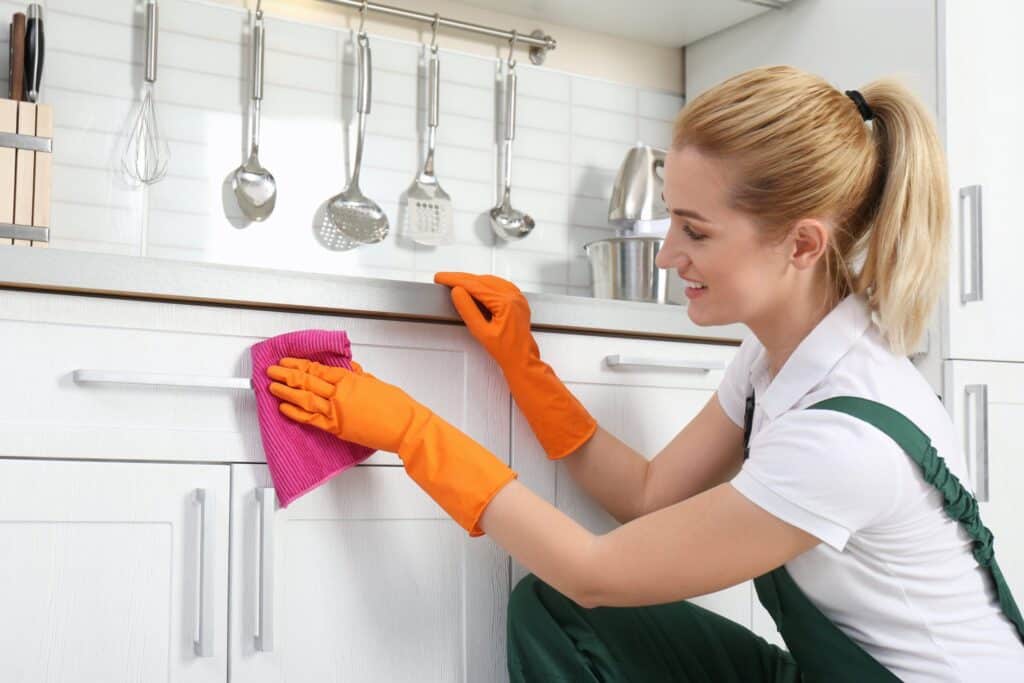
Can I spray vinegar on kitchen cabinets?
For your average everyday cleaning, keep a second spray bottle filled with equal parts vinegar and water. This will be plenty strong enough to clean and sanitize your average kitchen mess, spill or light clean-up. This mild 50/50 vinegar and water mix can be used to clean your cabinets as well.
An ammonia solution can be an effective method for killing black mold on cabinets. However, use it with caution and only in well-ventilated areas. Mix equal parts of ammonia and water, apply the solution to the affected areas, and let it sit for a few minutes before scrubbing and rinsing thoroughly.
When tackling black mold on cabinets, ensure you clean not only the visible mold but also the surrounding areas. Mold spores can spread easily, so a thorough cleaning is crucial to prevent its resurgence. After cleaning, thoroughly dry the cabinets to prevent moisture from lingering.
To keep black mold at bay, it’s essential to implement preventive measures. Regularly inspect your cabinets for signs of mold and address them promptly. Fix any leaks immediately to prevent moisture buildup. Ensure proper ventilation in the kitchen to minimize humidity levels. Consider using a dehumidifier to maintain optimal humidity levels and discourage mold growth.
Killing black mold on cabinets requires a proactive approach and adherence to safety guidelines. Natural cleaning solutions like white vinegar and baking soda, as well as essential oils, can be highly effective in eliminating black mold. In more severe cases, commercial mold cleaners or an ammonia solution may be necessary. Thorough cleaning and preventive measures are key to preventing black mold’s return and maintaining a clean and safe kitchen environment for you and your family.
What is the best chemical to clean cabinets?
Mix one part warm water and white vinegar in a spray bottle. For heavy buildup of grime and grease, you can add a couple of drops of dish soap. Spray the cleaning solution onto a microfiber cloth until it’s damp. Wipe down the cabinet doors and frames starting at the top.
An all-purpose cleaner is a versatile option suitable for most types of kitchen cabinets. Look for a cleaner labeled safe for use on wood, laminate, or other cabinet materials. All-purpose cleaners are effective in removing general dirt, grease, and grime from cabinet surfaces.
Mild dish soap mixed with water is a gentle yet effective option for cleaning cabinets, especially those made of wood or painted surfaces. It helps break down grease and grime without causing any damage.
White vinegar is an excellent natural cleaning agent that works well on various cabinet surfaces. Dilute white vinegar with water to create a solution and use it to remove dirt, grease, and mold from cabinets. However, avoid using vinegar on porous materials like natural stone.
Baking soda is another natural option for tackling stubborn stains and grease buildup on cabinets. Create a paste by mixing baking soda with water and use it to scrub away tough stains gently.
For cabinets made of wood, especially those with a protective finish, consider using commercial wood cleaners designed specifically for wooden surfaces. These cleaners are formulated to clean and nourish wood without causing any damage.
Citrus-based cleaners, containing natural oils from citrus fruits, are effective in cutting through grease and leaving a pleasant scent. These cleaners are safe for most cabinet surfaces, but it’s always a good idea to check the manufacturer’s instructions and test in an inconspicuous area first.
Cabinet polishes are designed to clean and protect the cabinet’s finish, providing a shiny and polished appearance. They can be used on various cabinet materials, including wood and laminate.
What is the best chemical to clean kitchen cabinets?
The best way to clean kitchen cabinets, no matter their finish, is with a simple mix of dish soap and warm water. Dish soap is strong enough to clean and degrease your cabinets but gentle enough that it won’t remove the finish. Here’s what to do: Fill your sink or a large bowl with warm water.
Mild dish soap mixed with water is a gentle yet effective option for cleaning kitchen cabinets, especially those made of wood or painted surfaces. It helps break down grease and grime without causing any damage to the cabinet’s finish.
White vinegar is an excellent natural cleaning agent that works well on various cabinet surfaces. Dilute white vinegar with water to create a solution and use it to remove dirt, grease, and grime from cabinets. However, avoid using vinegar on porous materials like natural stone.
Baking soda is another natural option for tackling tough stains and grease buildup on kitchen cabinets. Create a paste by mixing baking soda with water and use it to scrub away stubborn stains gently.
Citrus-based cleaners, containing natural oils from citrus fruits, are effective in cutting through grease and leaving a pleasant scent. These cleaners are safe for most cabinet surfaces, but it’s always a good idea to check the manufacturer’s instructions and test in an inconspicuous area first.
For cabinets made of wood, especially those with a protective finish, consider using commercial wood cleaners designed specifically for wooden surfaces. These cleaners are formulated to clean and nourish wood without causing any damage.
Cabinet polishes are designed to clean and protect the cabinet’s finish, providing a shiny and polished appearance. They can be used on various cabinet materials, including wood and laminate.
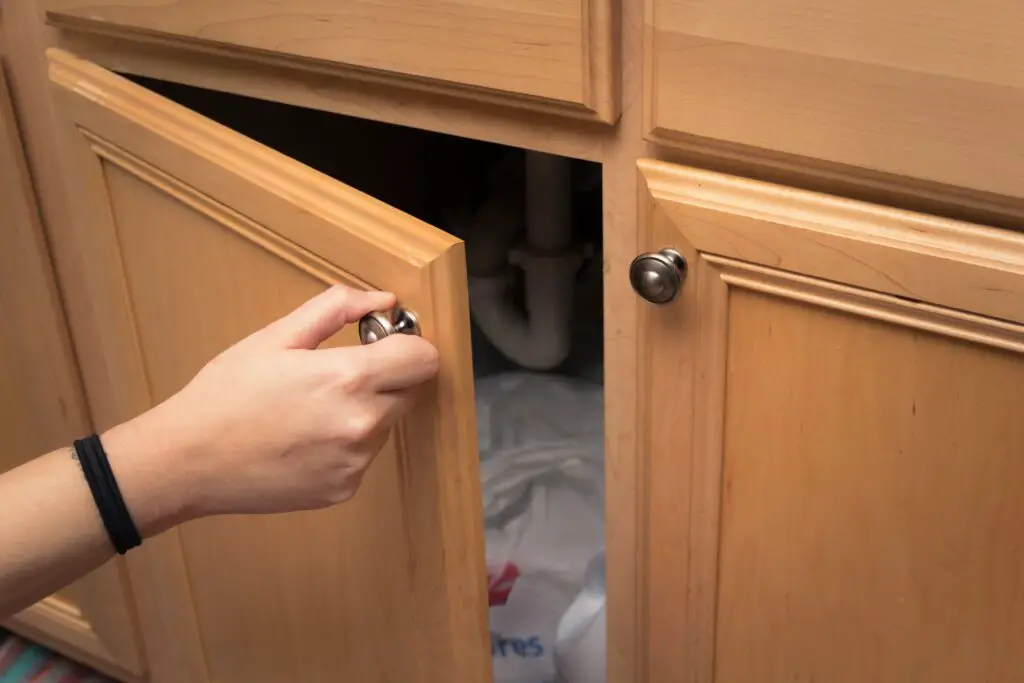
Conclusion
The importance of safety precautions when handling mold. Always wear protective gear to minimize direct contact with mold spores and potential respiratory issues. Assess the extent of mold infestation before starting the cleaning process. For small, localized patches, you can often manage the cleanup yourself, but for more severe cases, it’s best to seek professional help.
Equipped with the right cleaning supplies, such as a mild detergent, vinegar, baking soda, and essential oils with anti-fungal properties, you can confidently tackle the mold growth. Ensure you clean not only the visible mold but also the surrounding areas, as mold spores can easily spread and re-contaminate the cabinets.
After a thorough cleaning, focus on maintaining a dry and well-ventilated kitchen mold cabinet environment to prevent mold from returning. Fix any leaks promptly, use exhaust fans, and keep the area well-lit to discourage mold growth. Regularly inspect your cabinets to catch any early signs of mold and address them promptly. Lastly, remember that prevention is the best defense against mold. Routinely clean and dry your kitchen cabinets, avoid leaving wet or damp items inside, and periodically sanitize the surfaces to discourage mold growth.



